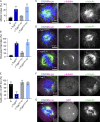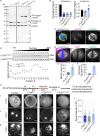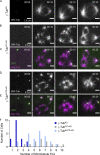A nucleotide binding-independent role for γ-tubulin in microtubule capping and cell division
- PMID: 36695784
- PMCID: PMC9930161
- DOI: 10.1083/jcb.202204102
A nucleotide binding-independent role for γ-tubulin in microtubule capping and cell division
Abstract
The γ-tubulin ring complex (γ-TuRC) has essential roles in centrosomal and non-centrosomal microtubule organization during vertebrate mitosis. While there have been important advances in understanding γ-TuRC-dependent microtubule nucleation, γ-TuRC capping of microtubule minus-ends remains poorly characterized. Here, we utilized biochemical reconstitutions and cellular assays to characterize the human γ-TuRC's capping activity. Single filament assays showed that the γ-TuRC remained associated with a nucleated microtubule for tens of minutes. In contrast, caps at dynamic microtubule minus-ends displayed lifetimes of ∼1 min. Reconstituted γ-TuRCs with nucleotide-binding deficient γ-tubulin (γ-tubulinΔGTP) formed ring-shaped complexes that did not nucleate microtubules but capped microtubule minus-ends with lifetimes similar to those measured for wild-type complexes. In dividing cells, microtubule regrowth assays revealed that while knockdown of γ-tubulin suppressed non-centrosomal microtubule formation, add-back of γ-tubulinΔGTP could substantially restore this process. Our results suggest that γ-TuRC capping is a nucleotide-binding-independent activity that plays a role in non-centrosomal microtubule organization during cell division.
© 2023 Berman et al.
Conflict of interest statement
Disclosures: The authors declare no competing interests exist.
Figures








Similar articles
-
CAMSAPs and nucleation-promoting factors control microtubule release from γ-TuRC.Nat Cell Biol. 2024 Mar;26(3):404-420. doi: 10.1038/s41556-024-01366-2. Epub 2024 Feb 29. Nat Cell Biol. 2024. PMID: 38424271 Free PMC article.
-
Microtubule nucleation: The waltz between γ-tubulin ring complex and associated proteins.Curr Opin Cell Biol. 2021 Feb;68:124-131. doi: 10.1016/j.ceb.2020.10.004. Epub 2020 Nov 12. Curr Opin Cell Biol. 2021. PMID: 33190097 Review.
-
GCP-WD mediates γ-TuRC recruitment and the geometry of microtubule nucleation in interphase arrays of Arabidopsis.Curr Biol. 2014 Nov 3;24(21):2548-55. doi: 10.1016/j.cub.2014.09.013. Epub 2014 Oct 16. Curr Biol. 2014. PMID: 25438942
-
TACC3 protein regulates microtubule nucleation by affecting γ-tubulin ring complexes.J Biol Chem. 2014 Nov 14;289(46):31719-31735. doi: 10.1074/jbc.M114.575100. Epub 2014 Sep 22. J Biol Chem. 2014. PMID: 25246530 Free PMC article.
-
Microtubule nucleation by γ-tubulin complexes and beyond.Essays Biochem. 2018 Dec 7;62(6):765-780. doi: 10.1042/EBC20180028. Print 2018 Dec 7. Essays Biochem. 2018. PMID: 30315097 Free PMC article. Review.
Cited by
-
CAMSAPs and nucleation-promoting factors control microtubule release from γ-TuRC.Nat Cell Biol. 2024 Mar;26(3):404-420. doi: 10.1038/s41556-024-01366-2. Epub 2024 Feb 29. Nat Cell Biol. 2024. PMID: 38424271 Free PMC article.
-
Microtubule choreography: spindle self-organization during cell division.Biophys Rev. 2024 Sep 30;16(5):613-624. doi: 10.1007/s12551-024-01236-z. eCollection 2024 Oct. Biophys Rev. 2024. PMID: 39618782 Free PMC article. Review.
-
The minus-end depolymerase KIF2A drives flux-like treadmilling of γTuRC-uncapped microtubules.J Cell Biol. 2023 Oct 2;222(10):e202304020. doi: 10.1083/jcb.202304020. Epub 2023 Aug 24. J Cell Biol. 2023. PMID: 37615667 Free PMC article.
-
Structure of the γ-tubulin ring complex-capped microtubule.Nat Struct Mol Biol. 2024 Jul;31(7):1124-1133. doi: 10.1038/s41594-024-01264-z. Epub 2024 Apr 12. Nat Struct Mol Biol. 2024. PMID: 38609661 Free PMC article.
References
Publication types
MeSH terms
Substances
Grants and funding
LinkOut - more resources
Full Text Sources
Research Materials
Miscellaneous

